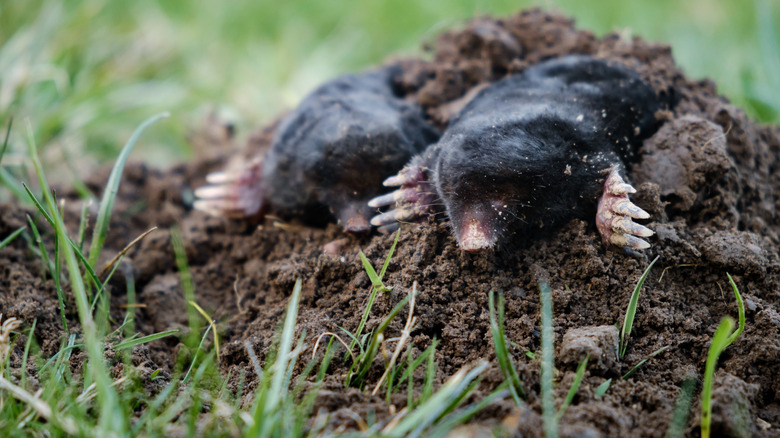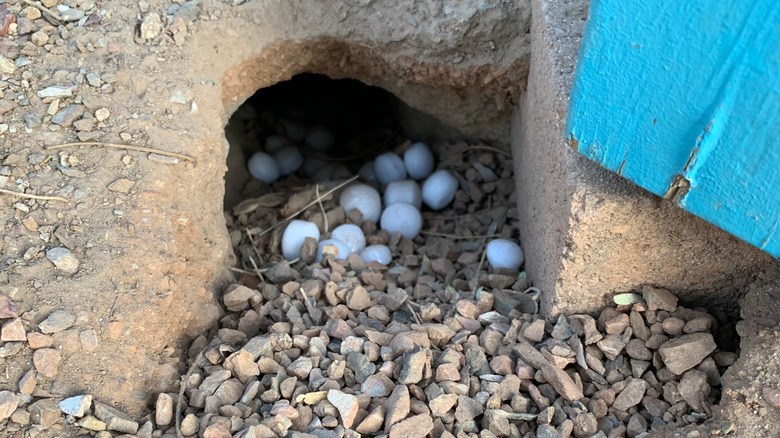Avoid This Popular Method When Trying To Deter Moles
If you're trying to get rid of the moles in your garden, you need a two-pronged approach. Arguably, the most important step is to discover the ways you're attracting unwanted moles to your yard before taking action. According to Purdue University, there are only two methods to remove the subterranean mammals. One is to remove them physically, and the other is to bait and trap the furry wonders. That means that the popular hack of sticking mothballs in your soil is not as effective as you may believe and that it may be doing more harm than good. Accordingly, you should avoid this repellent method because the scent alone isn't sufficient to deter moles, and it can also be environmentally damaging.
Why is it so difficult to get rid of moles? It comes down to their lifestyle. Typically, it's easy to see results if you're trying to eliminate a pest. But, when it comes to moles, you may never know if you have eliminated them as they are underground creatures who are rarely seen. Even in summer, when the soil becomes drier, they will follow the trek of the earthworms and other food sources, and bury themselves even deeper into the ground, while you mistakenly believe that they have left for clammier pastures. Together with a short gestation period of about 42 days, it becomes nearly impossible to know how many moles have taken up residence in your yard, because they repopulate very quickly. And that is a problem. But, do not compound the problem by throwing mothballs down their tunnels in an attempt to get rid of them.
Moles cannot be gassed out with mothballs
If eau de mothballs are unpleasant for humans, the stench is almost certainly unbearable for moles, right? Well, while moles may be irritated by the scent of mothballs, they will not run off and make a beeline for the neighbors' hills. Chances are that the grub hunters will just backtrack, abandon the tunnel, and proceed to build some more underground avenues. At a rate of over 16 feet in an hour, that could mean even worse damage to your garden.
In fact, you would need to douse your soil with a significant amount of mothballs for the rodents to be affected by the scent enough to be deterred from your yard. The practice of using naphthalene or paradichlorobenzene balls is ineffective and inconsistent because mothballs are manufactured to control moths and not moles. But, certain scents can be used as deterrents, and you can even keep your yard free of pesky moles with some stunning plants such as marigolds, mint, and even daffodils. These pungent flowers will also last a lot longer than mothballs, and will not contaminate your soil the way that mothballs do. So, let them cook.
Mothballs are toxic to the environment
Mothballs are not only ineffective at deterring moles from your garden, they're also harmful to the environment. Mothballs are regulated by the Environmental Protection Agency because if not used for their regulated and specific purpose, they can cause substantial damage to humans and the environment. The product contains significant amounts of either naphthalene or paradichlorobenzene. These active ingredients can contaminate the soil, plants, water, and even the air. So, while you're trying to rid your yard of those pesky moles, you could also be poisoning your environment with dangerous chemicals.
A better alternative is to use a sonic mole repellent that emits sound waves. The clever device creates vibrations, tricking the mole into believing that other animals are interested in the home that it created. As a solitary creature that prefers its own company, the threat of having to deal with other animals may be enough to send the velveteen burrower packing. Once you're sure that the moles are gone, you may need to start thinking about how to take care of the mole holes in your lawn. But with the critters out of the way, you can at least look forward to a well-manicured lawn in the future.


